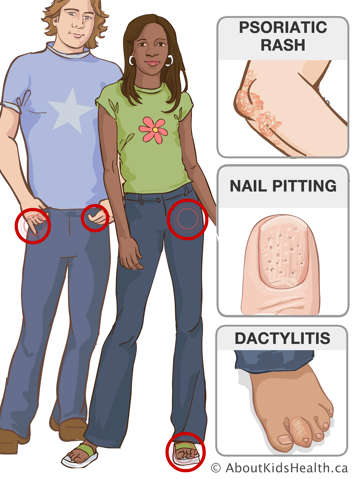Juvenile psoriatic arthritis is diagnosed in children or adolescents with arthritis AND either psoriasis or two of the following symptoms:
- typical nail changes seen in psoriasis called nail pits (little dents in the fingernails and/or toenails)
- dactylitis (sausage-like welling of the fingers and/or toes)
- a first-degree family member (parent or sibling) with psoriasis
Psoriasis is a skin disease. It is a scaly, red rash that can develop on the scalp, behind the ears, on the eyelids, elbows, knees or buttocks, or inside the belly button. Some people with psoriasis may also develop nail pits (tiny dents in their fingernails and toenails).
In children with juvenile psoriatic arthritis, the psoriasis may start before the arthritis, or the arthritis may develop before the psoriasis. A family history of psoriasis is an important clue to the correct diagnosis.

Quick facts about juvenile psoriatic arthritis
Here are a few more things you should know about juvenile psoriatic arthritis:
- It occurs in 3% to 10% of young people who have JIA.
- It can occur at any age.
- It affects both males and females equally.
- It can affect a few or many joints.
- It may involve the hips or back, similar to enthesitis-related arthritis.
- When the tendons of the fingers or toes become swollen or inflamed, they may look like sausages. This is called dactylitis.
- Psoriasis may cause little dents in the fingernails and toenails called nail pits.
- There is a moderate risk of eye disease, called uveitis.
Some children and adolescents have relatively mild psoriatic arthritis, and others have a more severe form. For some, it may resolve during childhood, and for others, it may persist into adulthood.
